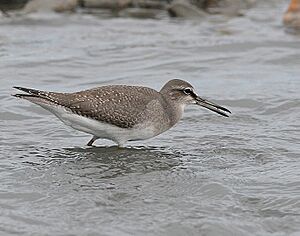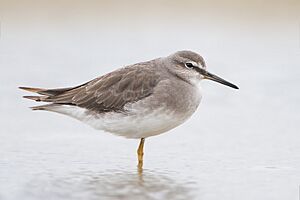Grey-tailed tattler facts for kids
Quick facts for kids Grey-tailed tattler |
|
|---|---|
 |
|
| Breeding plumage | |
 |
|
| Non-breeding plumage | |
| Conservation status | |
| Scientific classification | |
| Synonyms | |
|
Heteroscelus brevipes |
The grey-tailed tattler (Tringa brevipes) is a small shorebird. It's also called the Siberian tattler or Polynesian tattler. These birds get their name "tattler" because they make noisy calls. The word Tringa comes from an old Latin name for a similar bird. Brevipes means "short foot" in Latin, describing its short legs.
This tattler breeds in northeast Siberia. After breeding, they fly a long way to places like southeast Asia and Australia for winter.
Contents
What Does the Grey-tailed Tattler Look Like?
The grey-tailed tattler looks a lot like its cousin, the wandering tattler. The wandering tattler lives in North America. It can be hard to tell these two birds apart!
Both tattlers have plain, grey wings and backs. Their chests have a scaly pattern. This pattern often reaches down to their bellies when they are in breeding plumage. They also have a clear stripe above their eyes, called a supercilium.
Key Features of the Grey-tailed Tattler
These birds are similar in shape and size to common redshanks. Their upper parts, underwings, face, and neck are grey. Their bellies are white. They have short, yellowish legs. Their bill has a pale base and a dark tip.
How to Tell Them Apart
It's tricky to tell the grey-tailed tattler from the wandering tattler. You might look at small details. For example, the length of a groove on their nose or the scales on their lower legs.
The best way to tell them apart is by their calls. The grey-tailed tattler makes a two-note whistle. The wandering tattler makes a long, rippling trill sound.
Where Do Grey-tailed Tattlers Live and What Do They Do?
Grey-tailed tattlers breed on stony riverbeds in northeast Siberia. They build their nests on the ground. However, these birds can also perch in trees. Sometimes, they even use old nests built by other birds.
Migration and Winter Homes
These tattlers are very migratory. This means they travel long distances. They spend their winters on muddy and sandy coasts. You can find them from southeast Asia all the way to Australia.
They are rarely seen in western North America or western Europe. Grey-tailed tattlers usually don't gather in huge groups. You might see them in large flocks only when they are resting together.
What Do They Eat?
These birds find their food on the ground or in shallow water. They use their sight to pick up food. Their diet includes insects, crustaceans, and other small invertebrates.
Protecting the Grey-tailed Tattler
Different places have different rules to protect the grey-tailed tattler.
Conservation in Australia
In Australia, the grey-tailed tattler is not listed as "threatened" under a big national law. This law is called the Australian Environment Protection and Biodiversity Conservation Act 1999.
However, in the state of Victoria, Australia, the grey-tailed tattler is listed as "threatened." This is under the Victorian Flora and Fauna Guarantee Act (1988). An official plan to help this species recover has not yet been made. On a list from 2007, the grey-tailed tattler was called "critically endangered" in Victoria. This means it's at a very high risk of disappearing.


